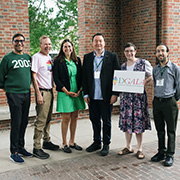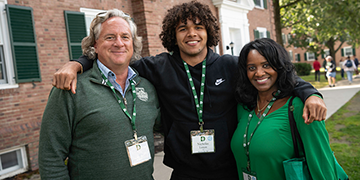Standing on Our Own Two Feet
Jeremy DeSilva tells us the Whys and Hows in this Short Talks on Big Ideas video
Apr 25, 2025
2 minute read
2 minute read
Archeology in the field can involve spending hours on your knees in a shallow pit, digging and sifting through dirt for artifacts in inhospitable climates. And much of the time, you come away with nothing to show for all the backbreaking work. That, says Professor of Anthropology Jeremy DeSilva, is part of the lesson he wants students to understand when they take part in a dig.
But sometimes good fortune shines its light on such diligence, just as it did in 2016 when Dartmouth students traveled to South Africa to get hands-on experience at a site known as Malapa—the “Cradle of Humankind.”
On the very last day of their week-long dig—as if from a reality TV script—students slowly coaxed a delicate artifact from the dirt: a two-million-year-old skeletal fragment from an extinct hominin known as Australopithecus sediba. It was a rare find. Indeed, the first-ever discovery of such a fossil had occurred just eight years prior.
The students’ new discovery raised old questions: A. Sediba predates the earliest examples of fossils from the genus Homo, so how it fits into the human record is an ongoing matter of scholarship—and findings like this serve to propel the inquiry.
In Short Talks on Big Ideas: Jeremy DeSilva on the Evolution of Upright Walking, DeSilva discusses the importance of exploring the human fossil record to discover how we “became human.” It turns out, we’re the only upright-walking hominids left. Why do we move on two legs, while all other mammals primarily travel on four?
“Walking on two legs was our first evolutionary event as we began to become the humans we are today,” DeSilva says. But we do so at a cost, he says, explaining how a human pelvis must be shaped to accommodate bi-pedalism—and eons ago led to cooperative parenting.
About Jeremy DeSilva
Jeremy "Jerry" DeSilva is a paleoanthropologist specializing in the locomotion of the first apes (hominoids) and early human ancestors (hominins). His anatomical expertise—the human foot and ankle—has contributed to our understanding of the origins and evolution of upright walking in the human lineage. DeSilva serves as the Department of Anthropology chair and is an honorary research fellow at the Evolutionary Studies Institute, University of the Witwatersrand in South Africa. He teaches the Ecology, Evolution, Environment and Society (EEES) graduate program and is the author of the 2021 book First Steps: How Upright Walking Made Us Human.
Professor DeSilva is also a champion of Dartmouth’s teacher-scholar model, in which faculty combines the roles of researchers and teachers to provide a unique learning experience for undergraduates who work alongside teachers to create new, actionable knowledge.






